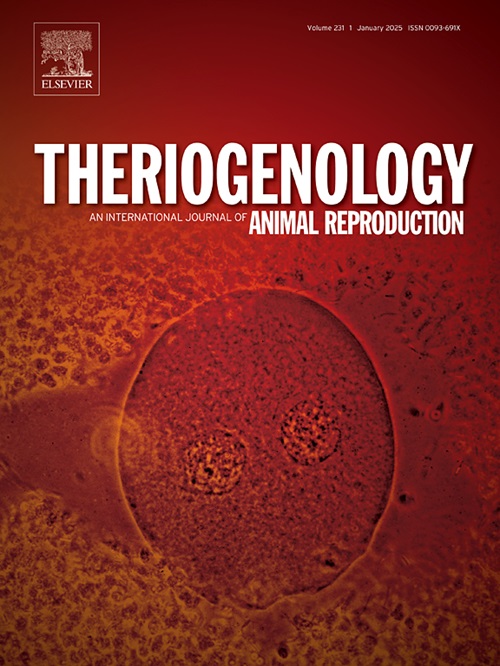在体外实验中,补充褪黑素并不能改善绵羊孵化前或孵化后的发育
IF 2.4
2区 农林科学
Q3 REPRODUCTIVE BIOLOGY
引用次数: 0
摘要
褪黑素在绵羊的繁殖季节性调节中起着至关重要的作用。褪黑激素的补充已被广泛应用于体内和体外卵母细胞成熟、受精和胚胎培养过程中,以提高生育能力和增殖能力。然而,其影响仅在体外评估,直到在常规胚胎培养系统中孵化囊胚阶段。本研究旨在评估卵母细胞体外成熟(IVM)至孵化后胚胎阶段补充褪黑素对前三个胚胎谱系发育的影响。在IVM、体外受精(IVF)和体外培养(IVC)期间,在10−8或10−6 M补充褪黑素对第8天(D)的卵裂率和囊胚率没有影响,对第12天的胚胎存活和生长也没有影响。虽然下胚层发育不受影响,但在D12胚胎中,从囊胚期开始,用10 - 6 M褪黑素处理后,外胚层存活率降低。综上所述,在孵化后的胚胎培养过程中,褪黑素对绵羊体外胚胎生产或谱系发育没有明显的有益影响。本文章由计算机程序翻译,如有差异,请以英文原文为准。
Melatonin supplementation does not improve ovine pre- or post-hatching development in vitro
Melatonin plays a crucial role in the regulation of reproductive seasonality in sheep. Melatonin supplementation has been widely used both in vivo to increase fertility and prolificacy, and in vitro during oocyte maturation, fertilization, and embryo culture. However, its effects have only been assessed in vitro up to the hatched blastocyst stage in conventional embryo culture systems. This study aimed to evaluate the effects of melatonin supplementation from oocyte in vitro maturation (IVM) through post-hatching embryonic stages in vitro on the development of the first three embryonic lineages. Supplementation with melatonin at 10−8 or 10−6 M during IVM, in vitro fertilization (IVF), and in vitro culture (IVC) did not affect cleavage and blastocyst rates at day (D) 8, nor embryo survival and growth at D12. While hypoblast development was not affected, epiblast survival was reduced in D12 embryos treated with 10−6 M melatonin from the blastocyst stage onward. In conclusion, melatonin supplementation did not show a clear beneficial effect on ovine in vitro embryo production or lineage development during post-hatching embryo culture.
求助全文
通过发布文献求助,成功后即可免费获取论文全文。
去求助
来源期刊

Theriogenology
农林科学-生殖生物学
CiteScore
5.50
自引率
14.30%
发文量
387
审稿时长
72 days
期刊介绍:
Theriogenology provides an international forum for researchers, clinicians, and industry professionals in animal reproductive biology. This acclaimed journal publishes articles on a wide range of topics in reproductive and developmental biology, of domestic mammal, avian, and aquatic species as well as wild species which are the object of veterinary care in research or conservation programs.
 求助内容:
求助内容: 应助结果提醒方式:
应助结果提醒方式:


